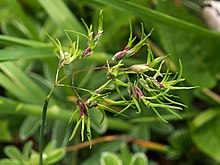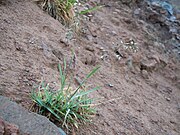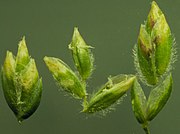Poa alpina, commonly known as alpine meadow-grass[1] or alpine bluegrass,[2][3] is a species of grass with a primarily holarctic distribution.[4]
| Poa alpina | |
|---|---|

| |
| A pseudoviviparous plant | |
| Scientific classification | |
| Kingdom: | Plantae |
| Clade: | Tracheophytes |
| Clade: | Angiosperms |
| Clade: | Monocots |
| Clade: | Commelinids |
| Order: | Poales |
| Family: | Poaceae |
| Subfamily: | Pooideae |
| Genus: | Poa |
| Species: | P. alpina
|
| Binomial name | |
| Poa alpina | |
It is noted for being pseudoviviparous: in place of seeds, it sometimes reproduces asexually, creating new plantlets in the spikelets.[5]
References
edit- ^ BSBI List 2007 (xls). Botanical Society of Britain and Ireland. Archived from the original (xls) on 2015-06-26. Retrieved 2014-10-17.
- ^ Poa alpina, Alpine bluegrass MNFI.
- ^ USDA, NRCS (n.d.). "Poa alpina". The PLANTS Database (plants.usda.gov). Greensboro, North Carolina: National Plant Data Team. Retrieved 8 October 2015.
- ^ "Poa alpina L." Plants of the World Online. Royal Botanic Gardens, Kew. Retrieved 22 January 2020.
- ^ Simon Pierce; Clare M. Stirling; Robert Baxter. "Pseudoviviparous Reproduction of Poa alpina...During Long-term Exposure to Elevated Atmospheric CO2" (PDF).[dead link]

